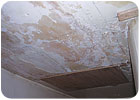
Photo 1: Water had come through the ceiling and peeled the paint layer.
This project was in the kitchen area of the home (photo 1). Water had come through the ceiling and peeled the paint layer. One of the first steps I took was to find out how extensive the damage was.
In a drywall finished home, I would have telltale signs that would help me know right away that the damage was limited to the paint layer and surface area. This is because around the damaged area the seams or nails with joint compound would become more visible. The water that caused the damage to the paint often will re-hydrate the joint compound over the nails and on the seams, especially the butt joints, and cause them to swell slightly or shrink. A gallon or so of water that comes down through a ceiling may spread out and require more repair than might first meet the eye. The repair of the drywall finished joints may also need to be addressed and fixed in this area, as well.
In this particular case, I could tell this was a plastered ceiling. So, I wanted to see how deep the problem was. My price estimating for this job is determined by how much work has to go into putting it back together. So I like to tap the ceiling and see if the finish coat has been affected. In other words, is it "hollow" sounding? Has the finish coat plaster separated from the basecoat underneath? Even with a lot of experience in this area, I still get surprised once in a while on how far the finish coat is affected. What starts out appearing to be a simple repair of 1 foot by 1 foot ends up being 3 or 4 feet in each direction.
Notice something else in the photo. There is a piece of wood molding in the corner. This separates the wall from the ceiling, which in this case limited the damage to the ceiling. This is not always the case. In the situation where the wallpaper meets the ceiling, it's a good idea to see if damage has spread down the wall, which often is the case, since the water has gravity on its side.
HOW FAR?
Another factor to keep in mind on any repair job and other projects is how far the homeowner wants the repairs to go. Listening to their concerns and opinions is key to a successful conclusion. I mention this only because lately I've met some homeowners who were not happy with the last repair person who took it upon themselves to dig and demolish where they did not want digging and demolishing going on!For instance, let's say the project that we're looking at did not have the piece of wood in the corner. And let's say the water damaged the plaster behind the wallpaper. Before I cut it away and do the repair to the wall area, it's a good idea to find out if they want to replace the paper. Some people just want to have the ceiling repaired and that's it. They are prepared to paint the ceiling and get things back close to what they were.
This point is also important in areas where the repair is going to affect a wall below the damaged ceiling area and where there is a corner involved. Damaged plaster may go around the corner and bubble up on an adjoining wall in another room. It may only be a small area (6 inches by 6 inches) that needs repaired. Make sure they know this beforehand, especially if the room is a different texture or different colored paint. They may want to leave that area alone. What we think is helpful may turn into a nightmare in their minds because now that entire wall in the room has to be painted. So, a good rule of thumb is just to define what areas are going to be repaired and what is not. It's difficult for me at times to leave areas that are begging to be repaired but that's just how things shake out sometimes.

Photo 2: Instead of patching this in, a previous repairman installed a piece of plywood.
NOW OR LATER
As far as estimating, one important thing that's becoming more of an issue with gas prices the way they are is: Will you do the repair now or later? It may be possible to estimate and do the work at the same time. I try and get as much information over the phone as I can, to understand what the problem is and how big the area is.This helps me determine if I'm going to bring along the materials and when I look at the project. I often will look at such a project in the morning, first thing. I often plan my day with my regular jobs starting around 9:00 or 9:30. This gives me an advantage. I can look at small repair jobs at 7:00 or 7:30 and as this particular job turned out, I was able to do the repairs on the spot. It was a one-hour repair. I scraped the loose paint and some finish coat that turned out to be about one foot square. I used a latex bonding agent and let that dry for about 15 minutes while I mixed up the plaster patch mix. It was a one coat job and I was gone within the hour, with a pricing of $225.
One reason the pricing was reasonable was I didn't have to go back. Going back may have added on $50 to $75 for the gas and return trip. I'll also add that doing repairs on the spot has a good impression on the homeowner, who often are stood up by workers that make appointments or who wait an hour or two past the time agreed upon.
People are super busy. Time is money. So the easier and faster you make it, the better. This also has the advantage that you can beat your competition from getting there to give a bid and get their foot in the door.
This ceiling was in bad shape to say the least. It was a hodge-podge of drywall and plaster. But the real kicker was Door #1 (photo 2). It was a hole that someone had cut into the ceiling to stop a leak some time before. Instead of patching it in, he simply installed a piece of plywood, which unfortunately seems to be a common material used to do these types of repairs (along with a few strips of duct tape thrown in for good measure).
He wanted the ceiling back to a smooth finish over the whole thing. The question that comes up is how to estimate it. I couldn't take the plywood down before I did the work, so asking the right questions is very important here. I wanted to know how long there had been a leak and if there was something to attach board into. I was guessing at an unknown, so I felt it was important to give a best/worst case scenario. If it was this much work to get the hole filled and things went well, it would be this price. If things were really bad up there, I'd have to charge this amount. This particular homeowner understood that I was at a disadvantage because I could not see the whole picture before I started, so things worked out OK.
###
The winner of the Walls & Ceilings/Plaster Man T-shirt is Joshua Siddle of Raleigh, N.C. If you want to enter the contest, simply send your name and address to this magazine or e-mail me atrobin@plasterzone.com. Until next time, Plaster On!

Report Abusive Comment